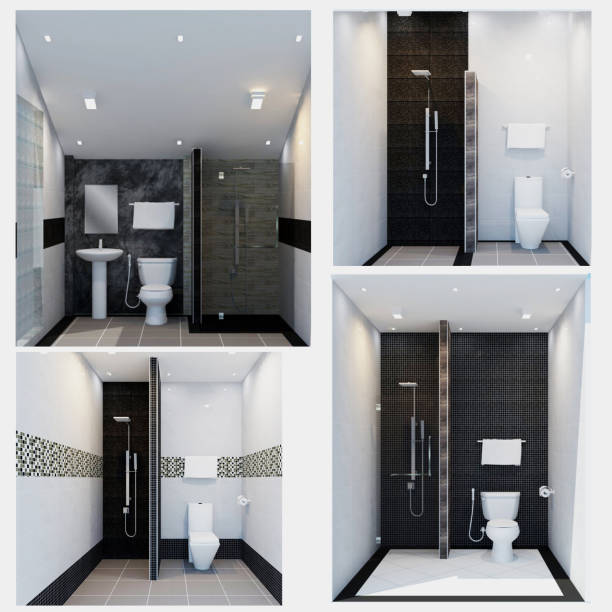Kitchen vs Bathroom tiles – What is the major difference

- The kitchen and bathroom share one thing in particular – a mixture of organic and inorganic chemical compounds. The use of space and expectations can differ despite the similarities. Your choice of tiles for the kitchen or tiles for the bathroom will also be different.
You would like to give both spaces the best possible look and feel. Your choice of tiles will be different for each room. Use tiles that are both aesthetically pleasing and functional.
KITCHEN TILES
Kitchens are one of the most susceptible areas to stains and spills. The tiles that you select should be easy to clean, durable, and stain-resistant.
Before choosing kitchen tiles, you should consider the following:
- Durable
- Stain-Resistant
- Easy to maintain
Ceramic tiles with glazed surfaces and glazed vitrified tile (GVT) offer the most variety in terms of design and texture. They are also extremely durable. Glossy wall tiles make it easier to remove food and oil residue. If you plan to use glass tiles as a backsplash for your kitchen, they are an excellent choice because they do not require much maintenance. Cork, vinyl, and stone tiles can be used for kitchen flooring because they are resistant to high traffic and hide stains.
It is better to use larger tiles for the kitchen than smaller tiles because they will look nicer. A straight pattern unifies other design elements in the kitchen. This particular look can also be achieved with different tile patterns such as herringbone and windmill.
Choose a tile that is both functional and beautiful for your walls. Consider it as a decorative feature that will breathe new life into your kitchen. You can use a variety of styles and patterns to make your kitchen look beautiful.
The wall and floor are two separate parts of the kitchen tiling.
Kitchen wall tiles
The easiest to maintain are wall tiles with a gloss finish. If you clean them regularly, matte and textured tiles are also attractive. Glossy tile can give a kitchen a more rich appearance, especially when there is natural light. Polished or shiny tiles are more resistant to stains than matte finish tiles. Using glossy tiles around the kitchen can improve hygiene and cleanliness.
It is best to select large-size tiles with a matt finish. This will give a nice look without being too bright, and it’s easy to clean.
Kitchen floor tiles
In today’s modern homes, extending the living room floor to the kitchen is an extremely popular practice. It creates a seamless look because most kitchens open up to the living room. When the flooring is extended into the kitchen, it is important to be cautious because water can spill easily and cause users to slip.
Keep the floor dry to avoid such accidents. If a separate kitchen, like in a restaurant or a hotel, is being used, the tiles on the floor must:
- Durable
- Scratch
- Skid Resistant
BATHROOM TILE
Choose a tile that is slip-resistant and resistant to water for your bathroom. Bathrooms are subjected to constant dampness, stains and high water flow.
Bathroom Space is usually affected by the following:
- Dampness
- Stains
- Continuous Water flow
It’s, therefore, important to choose a tile that is able to handle these situations. Bathroom tiles include porcelain, vitrified tiles, and ceramic tiles. They are perfect for bathroom walls and floors because they possess the necessary characteristics.
When selecting bathroom tiles, the most important factor is to maintain foot traction. The wrong tile can cause slip hazards. Bathrooms are usually small and you can use smaller tiles arranged diagonally to create the illusion of more space. Using large tiles can result in an uneven floor as the tiles need to be cut down to fit around the fittings.
When it comes to aesthetics, simple tile patterns are best for a clean, ultra-clean look. The colorful tiles would look out of place if you used the flooring in other areas. White, cream, and light gray are great options to create a relaxing and calm atmosphere in a small space like a bath.
The wall and floor are two separate parts of the bathroom tiling.
Bathroom wall tiles
There are many different surface finishes and styles to choose from. We must consider this carefully because the wall area of the bathroom is usually larger than the floor space. Here are some ideas for bathroom tile design:
- Select larger tiles to reduce the number of joints and to simplify cleaning and maintenance.
- A matt or soft surface in the bathroom will reduce reflections.
- Even nominal lighting can be made more effective by using lighter color glossy tiles. It makes the area safer.
- Use tiles with the option ” Virus-Free.” These tiles have an antimicrobial feature that prevents bacteria and fungus from growing, causing infection, bad odours and stains.
Bathroom floor tiles
Water and soapy liquids in the bathroom can increase the risk of sliding and slipping. It happens when a thin layer of soapy or watery liquid is on the surface. The risk of staining is significantly increased when the tile surface has a smooth, shiny finish. Therefore, anti-slip or skid-resistant tiles are recommended. When older people are living in the home, floor tiles that have a matt or textured surface will work best.
Things to consider when choosing tiles
There are several things to consider when choosing between bathroom and kitchen tiles. Before you head to the hardware store, you might want to view these factors to ensure that the tiles you purchase are suitable for the application you plan to use. It would be best if you kept in mind the following:
-
- Surface Durability and Scratch Resistant:
A busy kitchen has more foot traffic than a bathroom. The floor tiles of your kitchen should be rated higher for surface durability than those in your bathroom.
-
- Slip Resistant:
Bathroom tiles must always place safety first. The flooring of your bathroom should have an anti-slip rating. Slip rating is usually expressed as an R-value between 9 and 13. The slip rating is often given as R-value ranges between 9 and 13.
-
- Size and Number of Tiles:
Two factors determine the ideal tile size in your bathroom or kitchen – the available space and the slope of water drainage. For smaller bathrooms and kitchens, it is better to use smaller tiles (60x60cm or 30x30cm). They can provide more effective drainage and require less resizing. For larger bathrooms and kitchens, you can use bigger tiles (60×60 or 80×80 cm). Ensure that water drainage is maintained.




Leave a Reply